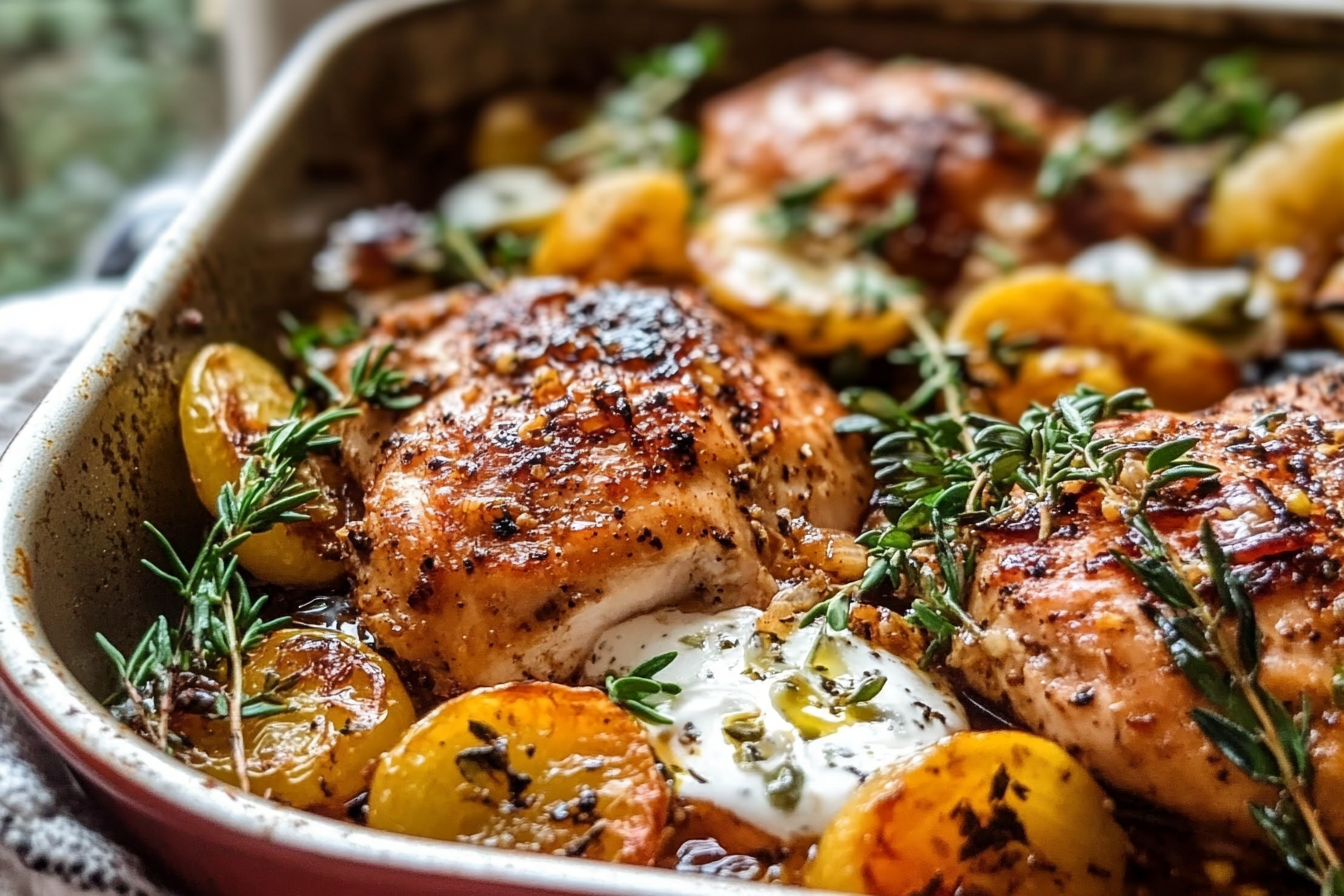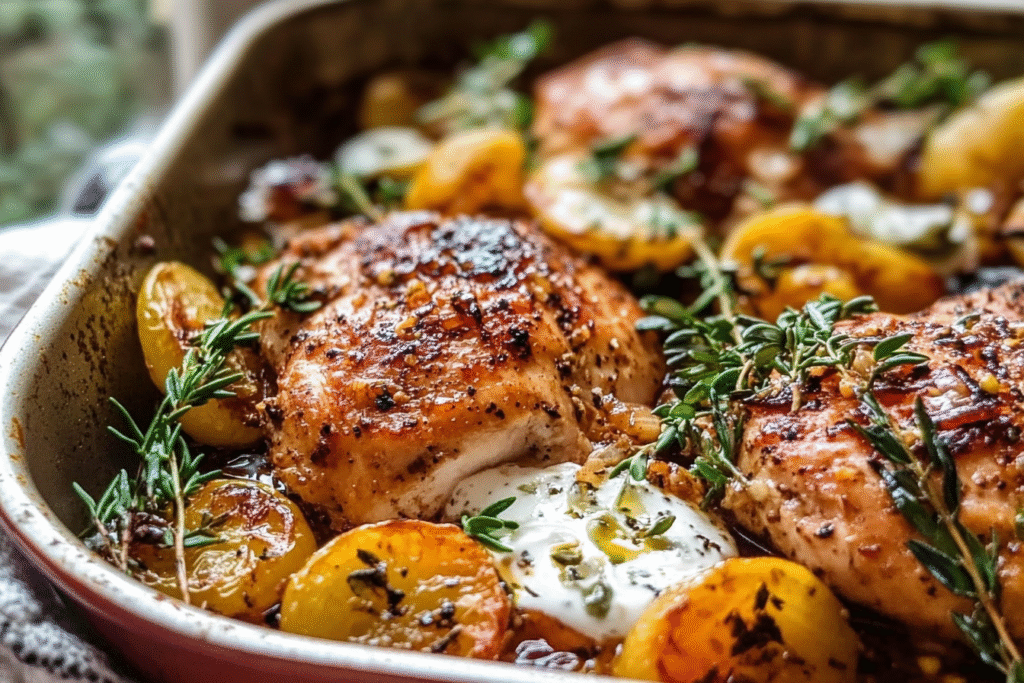
Looking for a flavorful, quick, and easy dinner that requires minimal cleanup? This One Pan Balsamic Chicken recipe is the answer. It features tender chicken breasts, fresh vegetables, and a rich, slightly sweet balsamic glaze—all cooked together in just one pan.
Perfect for busy weeknights or lazy weekends, this dish is as simple as it is satisfying. You don’t need fancy ingredients or multiple pots. Just a few pantry staples like balsamic vinegar (non-alcoholic), garlic, and olive oil bring everything together. There’s no wine, no pork, and nothing overly processed—just wholesome ingredients that turn into a comforting meal.
Whether you’re cooking for your family or prepping lunches for the week, this one-pan recipe offers bold flavors and balanced nutrition. It’s easy to customize, great for leftovers, and will quickly become a go-to favorite in your kitchen.
Why You’ll Love This One Pan Balsamic Chicken
There are so many reasons to love this One Pan Balsamic Chicken:
- Minimal cleanup: Everything cooks in one skillet—meat, veggies, and sauce—so you’ll have fewer dishes to deal with.
- Big flavor, simple ingredients: Pantry items like balsamic vinegar, honey, and garlic create a deeply flavorful glaze that tastes gourmet.
- Family-approved: This dish is mild yet delicious, making it great for kids and adults alike.
- Healthy and balanced: With lean protein and veggies in one dish, you get a nutritious meal without needing sides.
- Great for meal prep: Leftovers store well and taste even better the next day, making it perfect for planning ahead.
This dish is all about ease, flavor, and versatility. Once you try it, you’ll keep coming back for more.
What You’ll Need
This recipe keeps things simple by using everyday ingredients that come together to create bold, rich flavors. Everything is easy to find at your local grocery store, and there’s no need for any specialty items or alcohol-based components.
Main Ingredients:
- Chicken Breasts – 4 boneless, skinless (about 1.5–2 lbs total)
- Olive Oil – 2 tablespoons, for searing and sautéing
- Garlic – 4 cloves, minced
- Cherry Tomatoes – 1 ½ cups, halved
- Green Beans or Asparagus – 1 ½ cups, trimmed
- Red Onion – 1 medium, sliced thin
- Fresh Basil or Parsley – For garnish
For the Balsamic Glaze:
- Balsamic Vinegar (Non-Alcoholic) – ½ cup
- Honey – 2 tablespoons
- Low-Sodium Soy Sauce or Coconut Aminos – 1 tablespoon
- Dijon Mustard – 1 teaspoon
- Salt – 1 teaspoon
- Black Pepper – ½ teaspoon
Optional Additions:
- A sprinkle of shredded mozzarella or parmesan (optional for serving)
- Red pepper flakes for a slight kick
This combination gives you a well-balanced meal with lean protein, fiber-rich vegetables, and a savory-sweet glaze without the use of wine or processed meats. Feel free to swap vegetables based on what’s in season or what your family prefers.
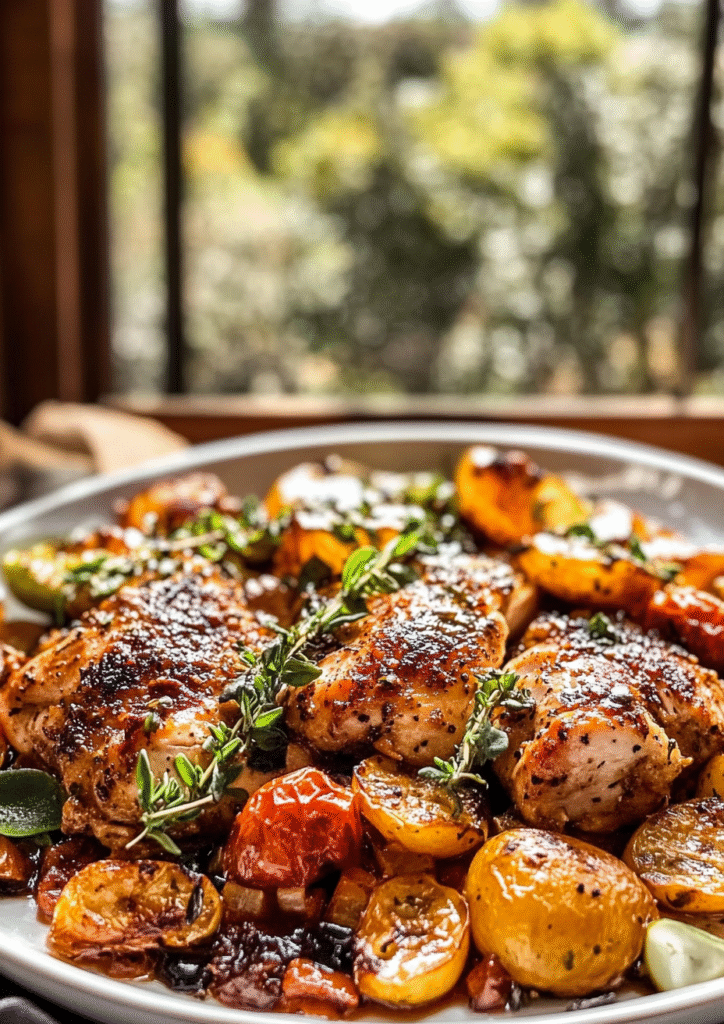
How to Make One Pan Balsamic Chicken
This recipe is all about convenience, and with just one skillet, you’ll have dinner on the table in under 30 minutes. Here’s how to make it:
Step 1: Prep the Ingredients
- Pat dry 4 chicken breasts and season both sides with salt and pepper.
- Mince 4 cloves of garlic.
- Slice 1 red onion, halve 1 ½ cups cherry tomatoes, and trim 1 ½ cups green beans or asparagus.
Step 2: Make the Balsamic Sauce
In a small bowl, whisk together:
- ½ cup balsamic vinegar
- 2 tbsp honey
- 1 tbsp soy sauce or coconut aminos
- 1 tsp Dijon mustard
- Pinch of black pepper and 1 tsp salt
Set aside.
Step 3: Sear the Chicken
- Heat 2 tbsp olive oil in a large skillet over medium-high heat.
- Add the chicken and sear for about 5–6 minutes per side, or until golden brown and mostly cooked through.
- Remove from pan and set aside.
Step 4: Sauté the Veggies
- In the same pan, add sliced onion, garlic, tomatoes, and green beans.
- Sauté for about 4–5 minutes until slightly softened.
Step 5: Bring It All Together
- Return the chicken to the pan.
- Pour the balsamic mixture over everything.
- Reduce heat to medium-low and let simmer for 8–10 minutes, allowing the sauce to thicken and coat the chicken and veggies.
Step 6: Garnish and Serve
- Sprinkle with fresh basil or parsley.
- Serve hot over rice, mashed potatoes, or quinoa.
It’s a one-pan, flavor-packed dinner that looks and tastes like it came from a restaurant—without the fuss.
You Must Know
Before you jump into making One Pan Balsamic Chicken, there are a few key things to keep in mind that can make the difference between a good dish and a great one. These tips will help you avoid common mistakes, improve flavor, and get the best results every time.
1. Balsamic Vinegar Matters
Not all balsamic vinegars are created equal. Choose a high-quality, non-alcoholic balsamic vinegar that’s naturally sweet and syrupy in texture. Lower-quality versions can taste overly acidic or watery, which will affect the balance of your glaze. If your balsamic vinegar is very sharp, you can mellow it with an extra teaspoon of honey or a splash of low-sodium broth.
2. Don’t Skip the Sear
Searing the chicken before adding the sauce and vegetables locks in moisture and adds rich flavor through caramelization. This step builds the base of your dish, so take the time to get a nice golden crust on each side. Just 5–6 minutes per side in a hot pan is usually enough.
3. Cut Vegetables Evenly
To ensure that everything cooks at the same rate, keep your veggies evenly sized. If you’re using firmer vegetables like carrots or broccoli, cut them smaller or steam briefly before adding to the pan. Softer veggies like cherry tomatoes and green beans can go straight into the skillet without pre-cooking.
4. Don’t Overcook the Chicken
Chicken breasts can become dry quickly if overcooked. Aim for an internal temperature of 165°F (74°C). Once it reaches that, pull the pan off the heat—even if the sauce is still thickening. Let the chicken rest in the glaze for a couple of minutes before serving.
5. The Sauce Thickens As It Cools
Your balsamic glaze may look thin right after simmering, but it thickens as it cools slightly. Be careful not to reduce it too much on the stove or it could become sticky and overly concentrated.
By understanding these key factors, you’ll avoid rookie mistakes and turn out a dish that’s juicy, flavorful, and balanced every time.
Perfecting the Cooking Process
Making One Pan Balsamic Chicken is simple, but there’s still room to elevate it from easy dinner to unforgettable meal. Here’s how to perfect your cooking process and get consistent, mouthwatering results every time you make it.
1. Use a Large, Heavy Skillet
A heavy-bottomed skillet (like cast iron or stainless steel) distributes heat more evenly and allows for a better sear. If your pan is too small, the chicken and vegetables will steam instead of caramelize, which can result in a soggy texture and less flavor.
2. Layer Your Flavors
Build flavor in layers. Start by searing the chicken, then sauté the garlic and onions until fragrant. This layering of flavors enhances the depth of the sauce without requiring extra seasonings or artificial flavor enhancers.
3. Let the Sauce Simmer Gently
When you add the balsamic glaze, lower the heat and let it simmer slowly. A gentle reduction ensures that the sauce thickens evenly without burning. Stir occasionally to prevent sticking.
4. Don’t Skip Deglazing
After searing the chicken, brown bits (fond) will stick to the pan. Pouring in the balsamic mixture deglazes the pan and lifts all that savory flavor into the sauce. Scrape the bottom of the skillet gently with a wooden spoon as the liquid hits—this adds complexity to your glaze.
5. Taste and Adjust Before Serving
Before serving, taste the sauce. If it’s too tangy for your liking, add a touch more honey. If it feels too sweet, balance it with a pinch of salt or a few drops of lemon juice.
6. Finish with Freshness
Garnishing with fresh basil or parsley right before serving adds brightness and color to the dish. It’s a simple touch that makes a big difference both in flavor and presentation.
By following these techniques, you elevate a simple skillet recipe into a dish that feels special—perfect for guests, family meals, or even date night at home.
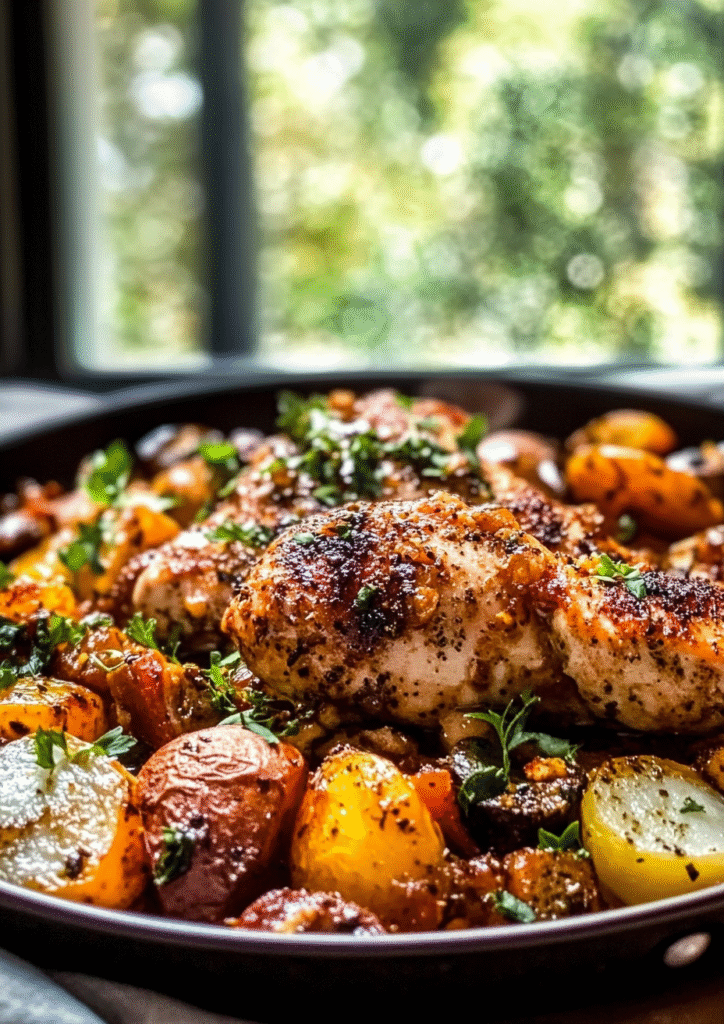
Add Your Touch One Pan Balsamic Chicken
One of the best things about this One Pan Balsamic Chicken is how easily it can be customized to fit your tastes, dietary needs, or seasonal ingredients. This dish is like a blank canvas—full of flavor as-is, but open to your creativity. Whether you’re feeding picky eaters or looking to put your own spin on dinner, here are some easy ways to add your personal touch.
1. Change Up the Protein
Not a fan of chicken breasts? Swap them for boneless, skinless chicken thighs—they stay juicy and add extra richness. Want something leaner? Try turkey cutlets. For a vegetarian option, substitute chicken with extra-firm tofu or chickpea patties, seared the same way for texture.
2. Try Different Vegetables
The beauty of this dish is that it works with almost any vegetable. Consider these swaps or additions:
- Zucchini or yellow squash for a summer twist
- Brussels sprouts, halved, for a hearty fall version
- Spinach or kale, added at the end for a quick wilt
- Mushrooms for an earthy depth
Just keep cook times in mind. Firmer veggies may need a few extra minutes, while leafy greens should go in last.
3. Make It Dairy-Friendly (or Not)
The recipe is naturally dairy-free, but if you’d like a creamy finish, you can top the dish with:
- A sprinkle of shredded mozzarella or parmesan
- A dollop of dairy-free cashew cream for a plant-based option
Both melt beautifully into the glaze and offer a different layer of texture and flavor.
4. Add Whole Grains
To turn this into a hearty grain bowl, serve over:
- Brown rice
- Quinoa
- Farro
You’ll add more fiber and nutrients while keeping it gluten-free and filling.
5. Spice It Up or Keep It Mild
Add a pinch of red pepper flakes for heat, or use smoked paprika to deepen the flavor without making it spicy. If you’re cooking for kids or prefer a milder version, keep the seasoning simple with garlic and herbs.
6. Finish with a Drizzle
A final drizzle of extra balsamic glaze or lemon juice can brighten the dish and make it pop, especially if you’ve added richer ingredients like cheese or mushrooms.
In the end, this recipe is designed to be yours. Don’t be afraid to make it different every time—use what’s in your fridge, tailor it to your preferences, and create your signature version of One Pan Balsamic Chicken.
Storing & Reheating
This dish isn’t just great fresh off the skillet—it also stores and reheats beautifully, making it a smart choice for leftovers and weekly meal prep. Whether you’re cooking ahead or saving some for later, here’s how to make the most of every bite.
Fans of family-friendly meals will definitely enjoy this one.
Refrigerating Leftovers
Store leftover chicken and vegetables in an airtight container. It will keep well in the refrigerator for up to 4 days. Make sure the chicken is cooled completely before storing to avoid excess moisture buildup, which can impact texture.
Tip: If you made a larger batch, consider storing individual portions in separate containers for quick grab-and-go meals throughout the week.
Freezing for Later
Yes, this recipe freezes well! Place cooled portions in freezer-safe bags or containers. For best quality, consume within 2 months. When ready to use, thaw overnight in the fridge before reheating.
Reheating Tips
To maintain the original flavor and texture, try one of these methods:
- Stovetop (Best Option):
Heat a drizzle of olive oil in a skillet over medium heat. Add the chicken and veggies and warm gently for about 6–8 minutes, stirring occasionally until heated through. - Microwave:
Place a serving in a microwave-safe dish, cover with a microwave-safe lid or wrap, and heat on medium power for 2–3 minutes. Stir halfway through for even heating. - Oven:
Preheat the oven to 350°F. Place leftovers in an oven-safe dish, cover with foil, and bake for 15–20 minutes or until heated through.
Avoid drying it out: If the balsamic glaze thickened too much in the fridge, add a splash of chicken broth, water, or a little more balsamic vinegar before reheating to loosen the sauce and revive its glossy texture.
What to Serve It With Later
Pair leftovers with freshly cooked grains or a quick green salad for a fast, balanced meal. You can even slice the leftover chicken and use it in wraps, over pasta, or in a lunchbox-friendly grain bowl.
One Pan Balsamic Chicken is the kind of dish that not only tastes amazing fresh—but also stays flavorful and satisfying as leftovers, helping you eat well all week long.
Chef’s Helpful Tips FOR One Pan Balsamic Chicken
Cooking at home should be delicious and stress-free. Here are my top chef-approved tips to ensure your One Pan Balsamic Chicken turns out flavorful, tender, and picture-perfect every time.
Try this simple, wholesome recipe that’s big on flavor.
1. Pound Chicken Evenly
If your chicken breasts are very thick, consider pounding them to an even thickness. This helps them cook evenly and prevents the outside from drying out while the inside is still undercooked. Aim for about ½ to ¾ inch thickness across each breast.
2. Let the Chicken Rest
After cooking, remove the skillet from heat and let the chicken sit in the pan for 5 minutes. This resting period allows the juices to redistribute, so you get a more tender and juicy bite.
3. Keep the Pan at Medium Heat
Don’t rush the glaze. Keep your pan at medium or medium-low when reducing the balsamic sauce. If it’s too hot, the sugars in the honey and vinegar may burn, creating a bitter taste. Slow simmering gives the sauce a glossy, syrup-like texture.
4. Don’t Overcrowd the Skillet
When searing the chicken or adding veggies, ensure there’s room in the pan. Overcrowding traps steam and prevents browning. If needed, cook in two batches—especially if using a smaller skillet.
5. Use Fresh Garlic, Not Powder
Minced fresh garlic is key here—it infuses the sauce with a savory depth that garlic powder can’t match. If you love garlic, feel free to add more than the recipe calls for!
6. Brighten It Before Serving
A squeeze of fresh lemon juice or a handful of chopped parsley right before serving can cut through the richness of the glaze and add a pop of freshness. It also boosts visual appeal.
7. Double the Sauce
If you love extra sauce for drizzling over rice or roasted potatoes, double the balsamic glaze ingredients. Just be sure to simmer a little longer to thicken it up without burning.
These pro tips help transform a simple one-pan dish into a flavorful, crave-worthy meal. It’s not just about following a recipe—it’s about understanding why each step matters so you can cook with confidence every time.
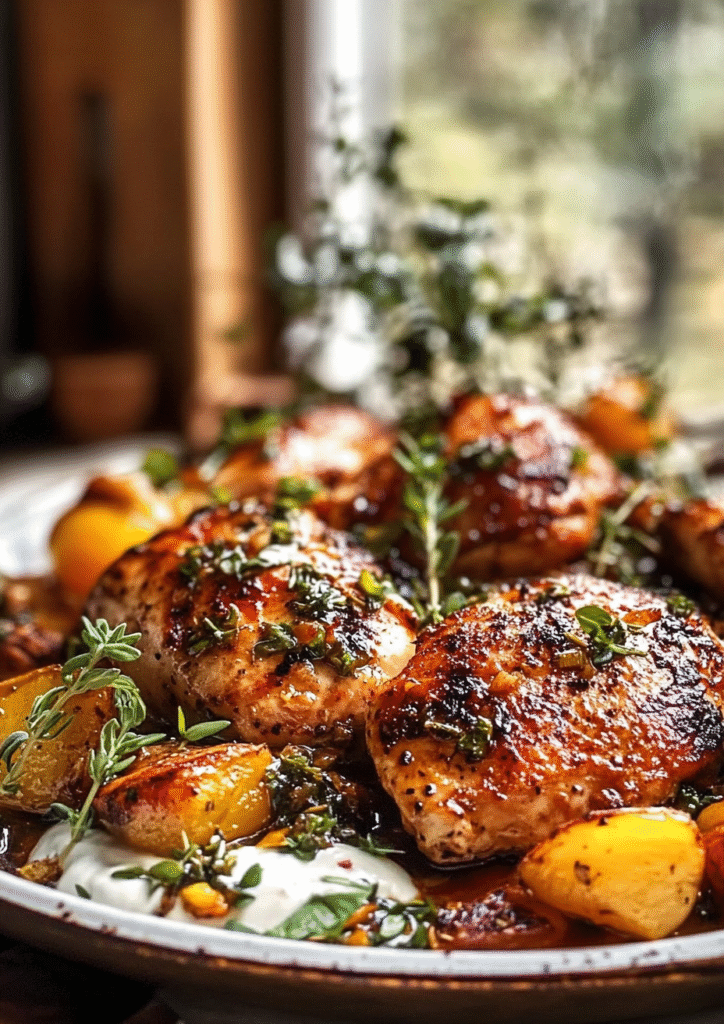
FAQ FOR One Pan Balsamic Chicken
Can I use frozen chicken breasts?
Yes, but be sure to thaw them completely before cooking. Using frozen chicken directly in the skillet will release excess water, which can prevent a proper sear and make the dish watery.
If you enjoy bold flavors with minimal effort, don’t miss this dish.
Can I make this recipe dairy-free and gluten-free?
Absolutely! It’s naturally dairy-free unless you add cheese at the end. For a gluten-free version, use gluten-free soy sauce or coconut aminos in the balsamic glaze. Always check labels to confirm.
Can I prep this meal ahead of time?
Yes! You can marinate the chicken in the balsamic mixture for up to 24 hours ahead. You can also pre-chop the vegetables and store everything separately in the fridge until ready to cook. This makes it perfect for busy weeknights.
What if I don’t have balsamic vinegar?
No worries! You can substitute with apple cider vinegar for a lighter, slightly tangier flavor. Add an extra touch of honey to balance the acidity. However, the classic balsamic really gives it that deep, signature flavor.
Can I add potatoes or grains directly to the pan?
Not recommended. While you can serve the chicken over roasted potatoes, rice, or quinoa, adding them directly to the pan may throw off the cooking time and soak up too much of the glaze. Cook your grains or starch separately for the best texture and flavor.
What’s the best pan to use?
A 12-inch stainless steel or cast iron skillet works best. It gives you plenty of space and even heat distribution, helping the chicken sear properly and the glaze reduce evenly.
Is this dish spicy?
Not at all—but it can be! Add a pinch of red pepper flakes or a few dashes of hot sauce to spice things up, or keep it mild for kids and sensitive eaters.
Conclusion
One Pan Balsamic Chicken is truly a standout recipe that balances simplicity with incredible flavor. It’s the kind of meal that feels special enough for company yet easy enough for a busy weeknight. By using fresh ingredients, a rich balsamic glaze, and a single skillet, you save time on both cooking and cleanup while creating a dish full of vibrant tastes and textures.
Whether you’re a beginner cook or an experienced home chef, this recipe is approachable and forgiving. It can be tailored to suit your family’s preferences, dietary needs, and whatever veggies you have on hand. Plus, the leftovers store and reheat beautifully, making it a perfect candidate for meal prep.
From the caramelized sear on the chicken to the tangy-sweet glaze that ties everything together, every bite offers comfort and satisfaction. Add your favorite sides, sprinkle on some fresh herbs, and enjoy a balanced meal with protein and veggies all in one pan.
If you’re looking to add a new staple to your dinner rotation—one that’s flavorful, quick, and fuss-free—give this One Pan Balsamic Chicken a try. It’s a recipe that ticks all the boxes: easy to make, packed with flavor, and sure to become a family favorite.
Happy cooking, and enjoy your delicious, hassle-free dinner!

The Best One Pan Balsamic Chicken for Meal Prep
Description
This quick and flavorful one pan balsamic chicken recipe features juicy seared chicken breasts with fresh vegetables, all coated in a tangy-sweet balsamic glaze. It’s a perfect weeknight dinner with minimal cleanup and maximum flavor.
Ingredients
Instructions
Sear Chicken: Season chicken with salt and pepper. Heat oil in a skillet over medium-high heat. Sear chicken for 5–6 minutes per side until golden. Remove and set aside.
Sauté Veggies: In the same skillet, add onion, garlic, tomatoes, and green beans. Cook 4–5 minutes until slightly tender.
Make Sauce: Whisk balsamic vinegar, honey, soy sauce, and mustard. Pour into skillet and stir.
Combine: Return chicken to the pan. Simmer on low for 8–10 minutes until chicken is cooked through and sauce thickens.
Serve: Garnish with fresh herbs and serve warm.
Notes
- Use high-quality balsamic vinegar for the best flavor.
Swap veggies based on the season—zucchini, bell peppers, or spinach work well.
For extra sauce, double the balsamic glaze ingredients.
Always check chicken doneness using a meat thermometer (165°F internal temperature).

